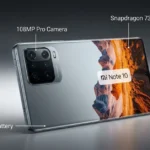The Motorola Edge 66 Neo 5G is tipped to make its India debut by mid-2026, positioned as a stylish yet performance-driven mid-range device under the popular Edge lineup. With an estimated price tag of ₹29,990–₹34,999 (ex-showroom), the phone builds upon the legacy of models like the Edge 60 Neo, delivering a refined design, high-speed 5G, and premium-grade hardware. Competing directly with Oppo F31 Pro, Vivo V40 Pro, and Redmi Note 15 Pro, the handset aims to bring flagship-inspired features at an approachable cost. Let’s explore its expected price, features, and performance as of August 30, 2025.

Premium Look and Sturdy Build
The Motorola Edge 66 Neo 5G is rumored to come with a slim and modern profile featuring either a curved glass or vegan leather rear finish paired with a strong aluminum chassis. Buyers may get options in Pantone-style shades such as Cosmic Blue, Velvet Red, Slate Grey, and gradient blends. The handset is expected to measure 161–163mm in length, 74–75mm in width, and 7.6–8.0mm in thickness, while weighing between 170–185 grams. With a screen-to-body ratio nearing 92–94%, it promises a classy, edge-to-edge viewing feel. Added toughness comes from IP68/IP69 ratings and MIL-STD-810H grade protection against dust, water splashes, and physical shocks.
Immersive AMOLED Display
At the front, users can expect a 6.6-inch pOLED panel with FHD+ or QHD+ resolution (2712×1224), combined with a blazing-fast 144Hz or 165Hz refresh rate. Brightness levels might reach 2500–3000 nits, ensuring sharp and colorful visuals for gaming, movies, and day-to-day scrolling. HDR10+ certification and 100% DCI-P3 coverage ensure lifelike contrast and rich tones. Handy features like wet-touch sensitivity, glove-friendly mode, and 2160Hz+ PWM dimming improve usability, though peak outdoor readability may still fall slightly behind ultra-premium QHD+ panels.
Flagship-Like Performance
Under the hood, the smartphone is likely to be powered by either the MediaTek Dimensity 7500 or Qualcomm Snapdragon 7 Gen 4 chipset, manufactured on an efficient 4nm process and clocked up to 2.8–3.0GHz. Paired with 8GB–12GB LPDDR5X RAM and 256GB–512GB UFS 4.0 storage, the Edge 66 Neo 5G is expected to score between 800,000–1,000,000 on AnTuTu benchmarks. This ensures smooth handling of AAA mobile games like BGMI at ultra settings, advanced video editing, and seamless multitasking. Out of the box, it will run Android 16 with Motorola’s Hello UI 2.0, offering Moto AI features such as gesture navigation, voice control, and AI-enhanced editing.
Camera Setup with AI Power
The triple-lens system may pack a 64MP primary sensor (f/1.7, OIS), a 13MP ultra-wide (f/2.2, 120° FoV), and a 10MP telephoto or macro sensor with 2x zoom. Expect crisp daylight shots, sharp 4K video recording, and improved low-light images thanks to Night Mode. The 32MP selfie shooter will likely support 4K video calls and AI-powered portraits. Video enthusiasts get features like 8K capture, slow-motion, Pro controls, and even AI image enhancements. However, ultra-wide and macro sensors might not perform as strongly in low light when compared to rivals like Vivo’s V40 Pro.
Long-Lasting Battery & Rapid Charging
The device is expected to sport a robust 5,200mAh battery, optimized to deliver 1.5–2 days of moderate-to-heavy usage with 7–9 hours of screen time. Motorola’s 80W TurboPower charging could top up the battery in just 25–30 minutes. A dedicated Battery Health Engine ensures long-term reliability, maintaining over 80% capacity even after four years. Certain variants may also include wireless charging support (20–30W), giving it an edge over earlier Neo series models.
Smooth 5G Connectivity
The Edge 66 Neo 5G will feature an extensive list of supported 5G bands, including n1, n3, n5, n7, n8, n28, n38, n40, n41, n77, and n78. In addition, it will pack Wi-Fi 6E, Bluetooth 5.4, NFC, USB-C, and dual-band GPS. A responsive in-display fingerprint scanner, dual SIM option, and Dolby Atmos-powered stereo speakers further enhance usability. The antenna design with 4×4 MIMO is expected to strengthen coverage even in weaker zones, although speaker loudness might not match ultra-flagship rivals.
Pricing & Launch Details
The expected pricing for the Motorola Edge 66 Neo 5G ranges between ₹29,990–₹34,999, depending on storage configuration, while Delhi on-road pricing could be ₹32,000–₹38,000 with taxes and insurance. It is anticipated to be listed across Motorola India’s official store, Flipkart, Amazon, Croma, Reliance Digital, and Bajaj Finserv outlets. Buyers may get 10–15% cashback offers on leading bank cards, no-cost EMI plans up to 12 months, and exchange deals worth ₹2,000–₹7,000. Servicing costs are moderate, estimated at ₹2,500–₹4,500 annually, supported by Motorola’s wide after-sales network.
Competitor Check
-
Oppo F31 Pro (₹26,990–₹33,999, Dimensity 7300, 50MP): Offers a bigger 7000mAh battery but lacks Motorola’s refined software.
-
Vivo V40 Pro (₹37,998–₹49,999, Dimensity 9200+, Zeiss optics): Stronger in cameras but far costlier.
-
Redmi Note 15 Pro (₹21,990, Dimensity 7300, 300MP sensor): More affordable but misses out on premium design elements.
Motorola’s key strengths remain its durable build, smooth UI, and immersive display, though photography may lag behind Vivo’s flagship line.
Final Verdict
The Motorola Edge 66 Neo 5G, arriving by mid-2026, positions itself as a premium mid-ranger that balances design, performance, and endurance. Its 144Hz AMOLED panel, 80W charging, robust protection ratings, and clean software make it a serious contender in the ₹30,000–₹35,000 space. While its cameras may not outshine every rival, its balance of performance, sleek form factor, and Motorola’s trust factor ensure it will be a compelling choice for Indian buyers seeking value without compromising on quality.
Hi, my name is Hussain, the author behind Nirmalahss. I’ve always been passionate about exploring the latest in technology and automobiles, and this platform is my way of sharing that passion with others. Over the years, I’ve followed new gadgets, software trends, and the ever-changing auto industry closely, which has helped me develop a strong understanding of what truly matters to everyday users.
